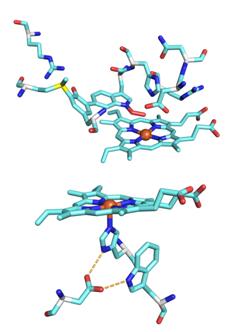Functional studies on catalase-peroxidases and design of mechanism-based inhibitors
SUPERVISOR: CHRISTIAN OBINGER
Project assigned to: BERNHARD GASSELHUBER
Background.
Oxidative stress and reactive oxygen species descending from both endo- and exogenous sources have evolved a sophisticated repertoire of ROS-degrading enzymes. The most abundant ROS is hydrogen peroxide and its dismutation is catalyzed by three different classes of enzymes; typical monofunctional catalases, manganese catalases and bifunctional catalase-peroxidases (KatG). KatGs appear as homodimeric proteins, with each subunit consisting of two homologous domains. This peculiar two-domain structure, where solely one domain accommodates a heme b and therefore an active site, probably arose from an ancient gene duplication and fusion event. The second domain has lost the conserved residues, which facilitate heme coordination and reactivity, but has been shown to be important for the overall conformational stability of the protein (Zamocky et al., 2010).
Catalase-peroxidases have raised considerable interest, since they degrade hydrogen peroxide by two different pathways within a single active site. Depending on the presence of appropriate substrates they either dismutate two molecules of hydrogen peroxide to molecular oxygen and water (catalatic activity) or reduce a single molecule of hydrogen peroxide and subsequently oxidize exogenous electron donors (peroxidatic activity). Although all three classes of hydrogen peroxide dismutating enzymes facilitate the same overall reaction, the active site architecture and the accompanying reaction scheme differ completely. (Zamocky et al., 2012).
Catalase-peroxidases are present in both prokaryotic and eukaryotic organisms. Fungal distribution has shown two well separated clades, namely an intracellular (KatG1) and an extracellular group (KatG2). The fact that the extracellular group is predominantly present in pathogenic fungi, suggests an important role in host/pathogen interaction (Zamocky et al. 2009). For the recently detailed characterized secreted catalase-peroxidase of the so called rice blast fungus Magnaporthe grisea, an influence on the infection of rice leaves has been shown. Plants defend themselves against invading pathogens by an unspecific action, secreting ROS like hydrogen peroxide. The fungi in turn detoxify this so called oxidative burst by their extracellular catalase-peroxidases (Tanabe et al., 2011). This renders the extracellular KatG2 group as an interesting target for further investigations regarding crop protection and modern pest management.
Aims and methods.
 The detailed reaction mechanism for both catalytic pathways of catalase-peroxidases, including occurring redox intermediates and possible radical sites, are still unknown. Catalase-peroxidases exhibit a unique posttranslational modification, the so called covalent adduct, in close vicinity to the heme. This modification is thought to act as an important radical site in KatGs enabling efficient oxidation of hydrogen peroxide and guaranteeing the release of dioxygen exclusively. Monofunctional peroxidases lack this covalent modification and are therefore not capable of degrading substantial amounts of hydrogen peroxide in absence of exogenous electron donors (Vlasits et al., 2010). In order to find a specific inhibitor, inactivating catalase-peroxidases exclusively without any influence on plant-derived monofunctional peroxidases, a detailed characterization of the KatG reaction mechanism and knowledge of all occurring redox and radical intermediates is needed.
The detailed reaction mechanism for both catalytic pathways of catalase-peroxidases, including occurring redox intermediates and possible radical sites, are still unknown. Catalase-peroxidases exhibit a unique posttranslational modification, the so called covalent adduct, in close vicinity to the heme. This modification is thought to act as an important radical site in KatGs enabling efficient oxidation of hydrogen peroxide and guaranteeing the release of dioxygen exclusively. Monofunctional peroxidases lack this covalent modification and are therefore not capable of degrading substantial amounts of hydrogen peroxide in absence of exogenous electron donors (Vlasits et al., 2010). In order to find a specific inhibitor, inactivating catalase-peroxidases exclusively without any influence on plant-derived monofunctional peroxidases, a detailed characterization of the KatG reaction mechanism and knowledge of all occurring redox and radical intermediates is needed.
Site-directed mutagenesis combined with a comprehensive set of spectroscopic methods, ranging from electrochemical investigations to pre-steady-state kinetics, should elucidate the detailed kinetics of interconversion of redox intermediates as well as electron donor (inhibitor) binding sites. The additional application of electron paramagnetic resonance together with potential spin traps and spin labeling experiments could identify occurring radicals in the catalatic turnover of KatGs. Together with in silico approaches these findings will help to find and design specific (mechanism-based) inhibitors thereby improving modern pest management of rice and other important cereals that are attacked by fungi having extracellular KatG2.
Tanabe, S., Ishii-Minami, N., Saitoh, K., Otake, Y., Kaku, H., Shibuya, H., Nishizawa, Y., Minami, E. (2011) The role of catalase-peroxidase secreted by Magnaporthe oryzae during early infection of rice cells. MPMI 24(2), 163-171
Vlasits, J., Jakopitsch, C., Bernroitner, M., Zamocky, M., Furtmüller, P.G., Obinger, C. (2010) Mechanisms of catalase activity of heme peroxidases. Arch. Biochem. Biophys. 500, 74-81
Zamocky, M., Furtmüller, P.G., Obinger C. (2009) Two distinct groups of fungal catalase/peroxidases. Biochem. Soc. Trans. 37, 772-777
Zamocky, M., Furtmüller, P.G., Obinger C. (2010) Evolution of structure and function of Class I peroxidases. Arch. Biochem. Biophys. 500, 45-57
Zamocky, M., Gasselhuber, B., Furtmüller P.G., Obinger, C. (2012) Molecular evolution of hydrogen peroxide degrading enzymes. Arch. Biochem. Biophys., in press
